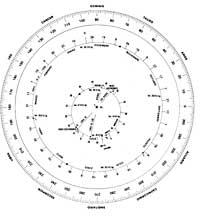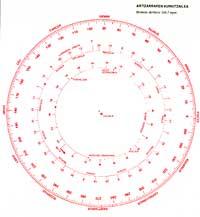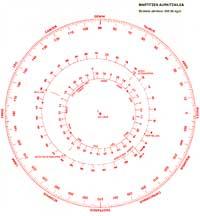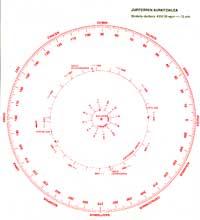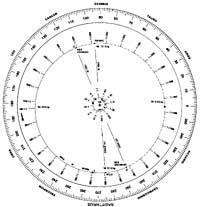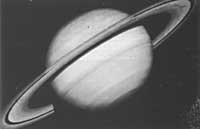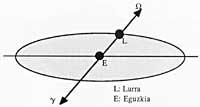Discoverers for planets
1990/04/01 Arregi Bengoa, Jesus Iturria: Elhuyar aldizkaria
To know the planets in the kneading, usually two warnings are given. The first, that they change their position with respect to the stars, although this change of position is evident in a few days; and the second, that they do not present any vibration, that is, they do not make gestures like those that make the stars continuously. But these only particularities are not of great help to know the planet. Among so many bright spots we can hardly find stars that have changed places in a few days or never appear. On the contrary, if we know more or less the position of the planet, the two mentioned particularities become very remarkable and, despite not having much habit of observing the kneading, it is easy to know these “erring astros”.
Therefore, as indicated in the previous number, we will give images that will help us know where the planets are going. These schemes are called “discoverers” and the five that can be seen at a glance will be displayed. To understand its use we will have to make a few brief notes on the ecliptic coordinates. If we consider kneading as the surface of a sphere are two numbers enough to find any point. All we have to do before is define a basic plane and a special point. The plane is defined by the Earth's orbit. This plane defines a maximum circumference which we shall call ecliptic, where it cuts the celestial sphere.
It is considered a region of 30 widths on both sides of the Ecliptic. This region is called Zodiako and contains the twelve Constellations corresponding to the horoscope. To locate the points of the sphere in the ecliptic is measured the first coordinate (ecliptic length), but for this we must define the origin. Its origin is the point of aries (), one of the two cutoff points between the ecliptic and the celestial equator, which limits the beginning of spring in the northern hemisphere. The second coordinate is the angle that forms with the plane of the ecliptic the line of eyes that goes from Earth to the star.
On the planet the orbit planes only separate a few degrees from the ecliptic. Therefore, since our goal is to identify the planets in the kneading, it will suffice to obtain its first coordinate (ecliptic length). It is what we will do through the discoverers.
In each of the discoverers is represented the Earth's orbit and the corresponding planet's orbit, to define the scale the radius of the Earth's orbit (149 million km.) used. The conveyor we have on the outside gives us an ecliptic length, as already indicated, from the point. However, this point is no longer in the Constellation of Aries, but in that of Pisces, due to the Earth's movement of precesion. In calculating the length we also see in what constellations we will find the planet. In the orbit of each planet are represented its perihelion and aphelion, as well as the ascending and decreasing nodes.
The latter are the plane of the planet's orbit and the velocities of the ecliptic. Therefore, they tell us that the planet after walking below the ecliptic passes to walk above (and vice versa). In the images, the orbit fragment below the ecliptic has been represented in scripts. The description of the discoverers ends with the following: That, except in the case of Jupiter, to start counting the days we have taken as origin the hour 0 of January 1, 1981. That is, we have taken as origin his position at that time and we must calculate to what extent he has moved according to the days that have passed since then until the date in which we want to know the position.
As the calculation of the positions of the planets we will do above all for the future, we will benefit from knowing that the days that have passed from the date of origin until January 1, 1990 (excluding this day) are 3287. In addition, the following table shows the days from the beginning of the year to the beginning of each month.
........................
Let us therefore explain how to use discoverers through two examples.
Mercury discoverer
Let us discover Mercury's position at 31 May 1990.
The Earth's position on this day can be found directly in the calendar indicated in its orbit.
To find Mercury's position we have to count the days that have passed through its origin: Days until the beginning of 1990: 3,287 more days in 1990, including 31 May: 151 = Total days 3,438
We will have to divide this amount in the Mercury turn period (87.97 days) to know how many turns it has formed and what is the sand. The number of turns is 39 and the sand of 7 days, that is, a lap will just start.
The radius of the conveyor we have depicted in the discoverer in the ecliptic to measure Mercury's position should be infinite, like his. To overcome this problem we will draw a line parallel to the line that connects the Earth with the calculated positions of Mercury from the Sun and the cut-off point with its transporter will give us an exact position. In this case we achieved a length of 43º, at the limit between Aries and Taurus.
Furthermore, as seen in the figure, the relative positions of the planets are very close to the maximum western elongation. Precisely that day reaches its maximum elongation of 25 °. Therefore, these days are the most suitable for observing them at Easter.
Discoverer of Venus
Let's discover the position of Venus on May 15. Calculation of days: Until 1 January 1990: 3,287 more Days of the current year, including 15 May: 135 = Total days 3,422
As the turning period of Venus is 224.7 days, the rest of the quotient is 51 days. The parallel to the line linking the Earth with the positions of Venus cuts the outer scale of the Sun to 10 in Pisces. Therefore, Venus can also be seen in the morning or in the second half of the night in this Constellation.
Discoverer of Martitz
Next May 15 is the ecliptic length of Mars.
The computation of days is what we have done for Venus: 3422. The Martitz turning period is 686.98 days, so the rest after the split is 674 days. Drawing the traditional parallels, the position of Mars is 347th in terms of its coordinate with the ecliptic, at the limit of the Constellations of Pisces-Aquarius. That is, it will come out before Venus but late.
Jupiter discoverer
On the same day of the previous case we will find your position. In this discoverer the days are represented in orbits. Therefore, we do not have to do calculations, but mark positions and draw directly the parallel. The ecliptic length is 100º in Gemini. As soon as it darkens we will see it in the garden, but not as high as we have seen in April. It is “falling” to the west.
Discoverer of Saturn
It is used as that of Jupiter. If we operate for the same day, the ecliptic length is 295th in Capricorn. Therefore, the night will appear ahead by the east, before Martitz.
Other noteworthy phenomena for this month are:
The Sun enters Gemini on May 21
...Phases of the Moon:
Ilbete, May 9 Cuarto
Menguante, May 17
Ilberri, May 24 The
Crescent, May 31
Finally we will say that in May you can see the Austin comet at a glance, just before dawn through the constellations of Andromeda and Pegasus. For more detail, it is best to use glasses.

Gai honi buruzko eduki gehiago
Elhuyarrek garatutako teknologia




